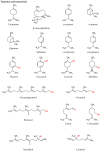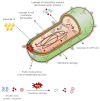Essential Oils and Their Major Components: An Updated Review on Antimicrobial Activities, Mechanism of Action and Their Potential Application in the Food Industry
- PMID: 35159614
- PMCID: PMC8833992
- DOI: 10.3390/foods11030464
Essential Oils and Their Major Components: An Updated Review on Antimicrobial Activities, Mechanism of Action and Their Potential Application in the Food Industry
Abstract
A novel alternative to synthetic preservatives is the use of natural products such as essential oil (EO) as a natural food-grade preservative. EOs are Generally Recognized as Safe (GRAS), so they could be considered an alternative way to increase the shelf-life of highly perishable food products by impeding the proliferation of food-borne pathogens. The mounting interest within the food industry and consumer preference for "natural" and "safe" products means that scientific evidence on plant-derived essential oils (EOs) needs to be examined in-depth, including the underlying mechanisms of action. Understanding the mechanism of action that individual components of EO exert on the cell is imperative to design strategies to eradicate food-borne pathogens. Results from published works showed that most EOs are more active against Gram-positive bacteria than Gram-negative bacteria due to the difference in the cell wall structure. In addition, the application of EOs at a commercial scale has been minimal, as their flavour and odour could be imparted to food. This review provides a comprehensive summary of the research carried out on EOs, emphasizing the antibacterial activity of fruit peel EOs, and the antibacterial mechanism of action of the individual components of EOs. A brief outline of recent contributions of EOs in the food matrix is highlighted. The findings from the literature have been encouraging, and further research is recommended to develop strategies for the application of EO at an industrial scale.
Keywords: antibacterial; antimicrobial; essential oil; mechanism of action; peel; preservation.
Conflict of interest statement
The authors declare no conflict of interest.
Figures
References
-
- Singh B., Singh J.P., Kaur A., Singh N. Antimicrobial potential of pomegranate peel: A review. Int. J. Food Sci. Technol. 2019;54:959–965. doi: 10.1111/ijfs.13964. - DOI
-
- Rios J.L. Essential Oils: What They Are and How the Terms Are Used and Defined. In: Preedy V.R., editor. Essential Oils in Food Preservation, Flavor and Safety. Academic Press; San Diego, CA, USA: 2016. pp. 3–10. Chapter 1.
-
- Martucci J.F., Gende L.B., Neira L.M., Ruseckaite R.A. Oregano and lavender essential oils as antioxidant and antimicrobial additives of biogenic gelatin films. Ind. Crop. Prod. 2015;71:205–213. doi: 10.1016/j.indcrop.2015.03.079. - DOI
Publication types
LinkOut - more resources
Full Text Sources




